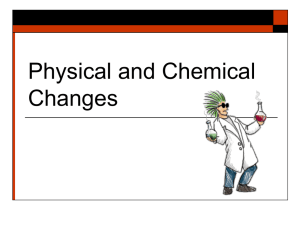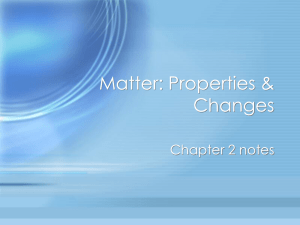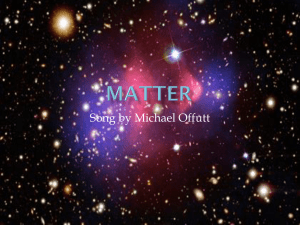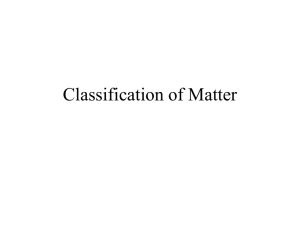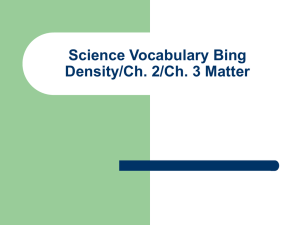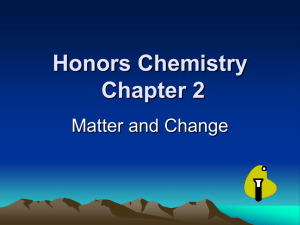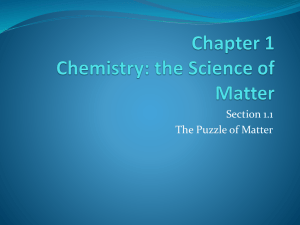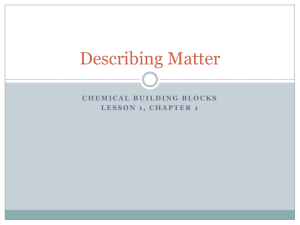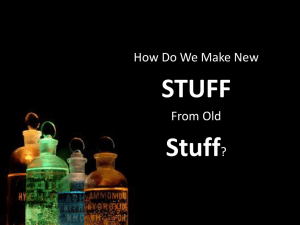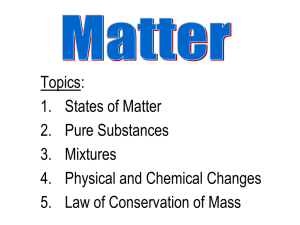Matter
advertisement
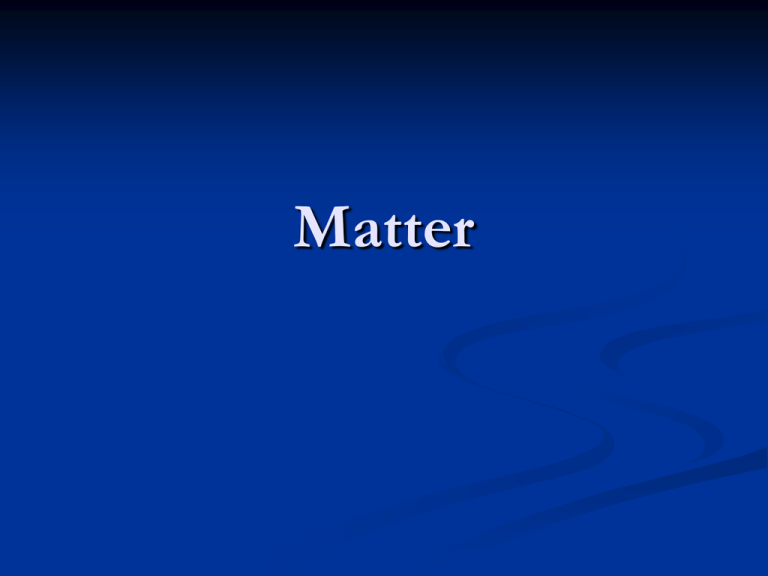
Matter Matter PA Standards 3.2.12.C: Inquiry and Design 3.4.10.A: Physical Science, Chemistry, and Physics 3.4.12.A: Physical Science, Chemistry, and Physics Apply the elements of scientific inquiry to solve multi-step problems. Explain concepts about the structure and properties of matter. Apply concepts about the structure and properties of matter. Section 1 Objectives: What is Matter? Explain the relationship between matter, atoms, and elements. Distinguish between elements and compounds. Describe molecules, and explain how they are formed. Interpret and write some common chemical formulas. Categorize materials as pure substances or mixtures. Explain the relationship between matter, atoms, and elements. Thought Questions Substances: Sugar Charcoal Hydrogen Oxygen How are these four substances related? How is sugar like the substances that form it? Can we mix these substances to form sugar? Why or why not? What is one way we can classify matter? Element, Compound, Mixture What is Matter? Matter is anything that has mass and takes up space. Which of the following are matter? Air Light Water Sound Element a substance that cannot be separated or broken down into simpler substances by chemical means Atom the smallest unit of an element that maintains the properties of that element “You are what you eat.” Elements in the Human Body Distinguish between elements and compounds. Composition of Matter Element Compound a substance made of atoms of two or more different elements that are chemically combined Composition of Matter Compounds have unique properties. • Every compound is different from the elements it contains. When elements combine to form a specific compound, they always combine in the same proportions. Activity “Mystery Mixture” Lab Set up Lab Describe molecules, and explain how they are formed. Composition of Matter, continued Molecules are the smallest unit of a substance that keeps all of the physical and chemical properties of that substance A molecule acts as a single unit. • Atoms can join together to make millions of molecules. Molecule Interpret and write some common chemical formulas. Composition of Matter Chemical formula a combination of chemical symbols and numbers to represent a substance. Chemical formulas represent compounds and molecules. • A chemical formula shows how many atoms of each element are in a unit of a substance. Composition of Matter • What is the chemical formula for glucose? • C6H12O6 Categorize materials as pure substances or mixtures. Activity “Mystery Mixture” Lab Observation 1 Pure Substances and Mixtures Mixtures are formed by mixing pure substances. Pure substance a sample of matter, either a single element or a single compound, that has definite chemical and physical properties Mixture a combination of two or more substances that are not chemically combined Pure Substances and Mixtures Mixtures are classified by how thoroughly the substances mix. Heterogeneous mixture substances aren’t mixed uniformly and are not evenly distributed Homogeneous mixture substances are evenly distributed, and the mixture is the same throughout Miscible substances that can be mixed Immiscible substances that cannot be mixed Pure Substances and Mixtures Pure Substances and Mixtures Gases can mix with gases. • Air is a mixture of gases. Gases can mix with liquids. Activity “Mystery Mixture” Lab Observation 2 Analysis/Conclusion Thought Questions Classify each of the following as an element or compound: Sulfur, S8 Methane, CH4 Carbon Monoxide, CO Cobalt, Co David says, “Pure honey has nothing else added.” Susan says, “The honey is not really pure. It is a mixture of many substances.” Who is right? Explain your answer. While in the library working on a Physical Science research project you get a coffee. Is the coffee a pure substance or a mixture? Now you add cream and sugar. Is the coffee a pure substance or a mixture? Explain.
